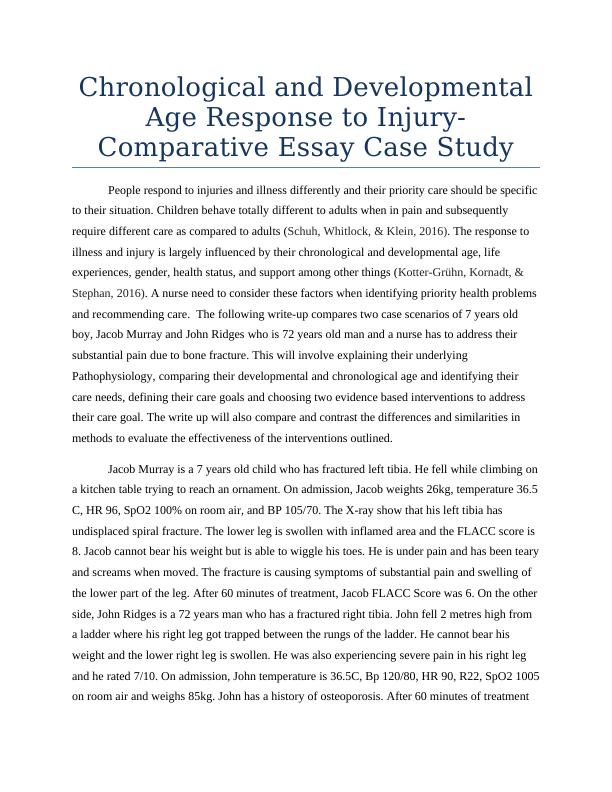Chronological and Developmental Age Case Study 2022
Compare and contrast the current literature around evidence based practice related to meeting the individual care needs of the cases in relation to ONE priority nursing problem.
7 Pages2491 Words43 Views
Added on 2022-10-08
Chronological and Developmental Age Case Study 2022
Compare and contrast the current literature around evidence based practice related to meeting the individual care needs of the cases in relation to ONE priority nursing problem.
Added on 2022-10-08
ShareRelated Documents
UNIT:
NAME:
DATE:
NAME:
DATE:

Chronological and Developmental
Age Response to Injury-
Comparative Essay Case Study
People respond to injuries and illness differently and their priority care should be specific
to their situation. Children behave totally different to adults when in pain and subsequently
require different care as compared to adults (Schuh, Whitlock, & Klein, 2016). The response to
illness and injury is largely influenced by their chronological and developmental age, life
experiences, gender, health status, and support among other things (Kotter-Grühn, Kornadt, &
Stephan, 2016). A nurse need to consider these factors when identifying priority health problems
and recommending care. The following write-up compares two case scenarios of 7 years old
boy, Jacob Murray and John Ridges who is 72 years old man and a nurse has to address their
substantial pain due to bone fracture. This will involve explaining their underlying
Pathophysiology, comparing their developmental and chronological age and identifying their
care needs, defining their care goals and choosing two evidence based interventions to address
their care goal. The write up will also compare and contrast the differences and similarities in
methods to evaluate the effectiveness of the interventions outlined.
Jacob Murray is a 7 years old child who has fractured left tibia. He fell while climbing on
a kitchen table trying to reach an ornament. On admission, Jacob weights 26kg, temperature 36.5
C, HR 96, SpO2 100% on room air, and BP 105/70. The X-ray show that his left tibia has
undisplaced spiral fracture. The lower leg is swollen with inflamed area and the FLACC score is
8. Jacob cannot bear his weight but is able to wiggle his toes. He is under pain and has been teary
and screams when moved. The fracture is causing symptoms of substantial pain and swelling of
the lower part of the leg. After 60 minutes of treatment, Jacob FLACC Score was 6. On the other
side, John Ridges is a 72 years man who has a fractured right tibia. John fell 2 metres high from
a ladder where his right leg got trapped between the rungs of the ladder. He cannot bear his
weight and the lower right leg is swollen. He was also experiencing severe pain in his right leg
and he rated 7/10. On admission, John temperature is 36.5C, Bp 120/80, HR 90, R22, SpO2 1005
on room air and weighs 85kg. John has a history of osteoporosis. After 60 minutes of treatment
Age Response to Injury-
Comparative Essay Case Study
People respond to injuries and illness differently and their priority care should be specific
to their situation. Children behave totally different to adults when in pain and subsequently
require different care as compared to adults (Schuh, Whitlock, & Klein, 2016). The response to
illness and injury is largely influenced by their chronological and developmental age, life
experiences, gender, health status, and support among other things (Kotter-Grühn, Kornadt, &
Stephan, 2016). A nurse need to consider these factors when identifying priority health problems
and recommending care. The following write-up compares two case scenarios of 7 years old
boy, Jacob Murray and John Ridges who is 72 years old man and a nurse has to address their
substantial pain due to bone fracture. This will involve explaining their underlying
Pathophysiology, comparing their developmental and chronological age and identifying their
care needs, defining their care goals and choosing two evidence based interventions to address
their care goal. The write up will also compare and contrast the differences and similarities in
methods to evaluate the effectiveness of the interventions outlined.
Jacob Murray is a 7 years old child who has fractured left tibia. He fell while climbing on
a kitchen table trying to reach an ornament. On admission, Jacob weights 26kg, temperature 36.5
C, HR 96, SpO2 100% on room air, and BP 105/70. The X-ray show that his left tibia has
undisplaced spiral fracture. The lower leg is swollen with inflamed area and the FLACC score is
8. Jacob cannot bear his weight but is able to wiggle his toes. He is under pain and has been teary
and screams when moved. The fracture is causing symptoms of substantial pain and swelling of
the lower part of the leg. After 60 minutes of treatment, Jacob FLACC Score was 6. On the other
side, John Ridges is a 72 years man who has a fractured right tibia. John fell 2 metres high from
a ladder where his right leg got trapped between the rungs of the ladder. He cannot bear his
weight and the lower right leg is swollen. He was also experiencing severe pain in his right leg
and he rated 7/10. On admission, John temperature is 36.5C, Bp 120/80, HR 90, R22, SpO2 1005
on room air and weighs 85kg. John has a history of osteoporosis. After 60 minutes of treatment

the pain score was 5/10. Therefore, the presence of osteoporosis contributed to the weakening the
bones of john.
Jacob and John substantial pain assessment is different because of their developmental
and chronological age. Jacob is a child and cannot effectively communicate verbally the pain he
is experiencing while John is an old adult who cannot objectively communicate and rate the pain
he is experiencing (Kooij, de Lange, Jansen, & Dikkers, 2013). There is a risk of overrating
Jacob’s pain score because children are teary when they experience pain. Jacob was teary and
inconsolable and screamed when moved. John on the other hand risks underrating the pain as
older adults hardly express pain through their behaviour (Abdulla et al., 2013). Though John
grimaced when moved, he stated that he will be alright and just needed to given a couple of
panadols. Jacob’s pain assessment should be behavioural based to minimise contributing risks of
overrating the pain level (Babl et al., 2012). The behavioural approach can consider the facial
expressions, leg movement, level of activities, cry and if he is consolable (Crellin, Harrison,
Santamaria, Huque, & Babl, 2018). On the other hand, John’s pain assessment approach can be
verbally based. John can be objectively guided by a nurse to describe and rate the pain level he is
experiencing. This approach has to describe pain in terms of severity, duration and type of pain
(Shaban, Holzhauser, Gillespie, Huckson, & Bennetts, 2012).
Jacob and John have a pain level above 5/10. This level of pain is substantial and there is
need to reduce it. The care goal is to reduce the pain level to 0/10 in the next three days. In the
third day they should not be feeling any pain and they will be comfortable as they get care to
heal their fractured limb.
Jacob and John need care interventions that will enable pain level reduction to 0/10.
These interventions are immobilization and elevation and rest. Elevation and resting intervention
involves raising the injured limb slightly above the heart level. Elevation of the affected part of
the body will decrease swelling hence reducing pain (Gourde, & Damian, 2012). Resting is an
essential part of therapy that promotes a fracture healing process (Abdulla et al., 2013). The
second intervention for Jacob and John is immobilization of the leg. This intervention will hold
the fractured tibia bone in place. This will prevent the injury from moving while it starting the
healing process. In this case scenario, John’s and Jacobs’s leg will require immobilization and
will extend to the joint below. Immobilization helps restrict movement that can lead to twisting
bones of john.
Jacob and John substantial pain assessment is different because of their developmental
and chronological age. Jacob is a child and cannot effectively communicate verbally the pain he
is experiencing while John is an old adult who cannot objectively communicate and rate the pain
he is experiencing (Kooij, de Lange, Jansen, & Dikkers, 2013). There is a risk of overrating
Jacob’s pain score because children are teary when they experience pain. Jacob was teary and
inconsolable and screamed when moved. John on the other hand risks underrating the pain as
older adults hardly express pain through their behaviour (Abdulla et al., 2013). Though John
grimaced when moved, he stated that he will be alright and just needed to given a couple of
panadols. Jacob’s pain assessment should be behavioural based to minimise contributing risks of
overrating the pain level (Babl et al., 2012). The behavioural approach can consider the facial
expressions, leg movement, level of activities, cry and if he is consolable (Crellin, Harrison,
Santamaria, Huque, & Babl, 2018). On the other hand, John’s pain assessment approach can be
verbally based. John can be objectively guided by a nurse to describe and rate the pain level he is
experiencing. This approach has to describe pain in terms of severity, duration and type of pain
(Shaban, Holzhauser, Gillespie, Huckson, & Bennetts, 2012).
Jacob and John have a pain level above 5/10. This level of pain is substantial and there is
need to reduce it. The care goal is to reduce the pain level to 0/10 in the next three days. In the
third day they should not be feeling any pain and they will be comfortable as they get care to
heal their fractured limb.
Jacob and John need care interventions that will enable pain level reduction to 0/10.
These interventions are immobilization and elevation and rest. Elevation and resting intervention
involves raising the injured limb slightly above the heart level. Elevation of the affected part of
the body will decrease swelling hence reducing pain (Gourde, & Damian, 2012). Resting is an
essential part of therapy that promotes a fracture healing process (Abdulla et al., 2013). The
second intervention for Jacob and John is immobilization of the leg. This intervention will hold
the fractured tibia bone in place. This will prevent the injury from moving while it starting the
healing process. In this case scenario, John’s and Jacobs’s leg will require immobilization and
will extend to the joint below. Immobilization helps restrict movement that can lead to twisting

End of preview
Want to access all the pages? Upload your documents or become a member.
Related Documents
Fall Risk Assessment and Interventions for Patients with Mobility Limitationslg...
|10
|2596
|495
Assignment On Issue Of Developmental And Chronological Agelg...
|10
|2220
|26
